Morning sunlight exposure maximizes your body's natural hormone production cycle by triggering key processes that boost testosterone. Your body's testosterone peaks between 7-10 AM, and exposure to bright morning light increases luteinizing hormone by 69.5%, directly stimulating more testosterone production. You'll also benefit from optimized cortisol levels that enhance alertness and energy, while proper melatonin suppression aligns your internal clock with the day-night cycle. Morning light activates your hypothalamus and pituitary gland, creating a powerful hormonal cascade effect. Understanding the specific timing and intensity of light exposure can help you access even greater hormone-optimizing benefits.
The Science Behind Morning Light
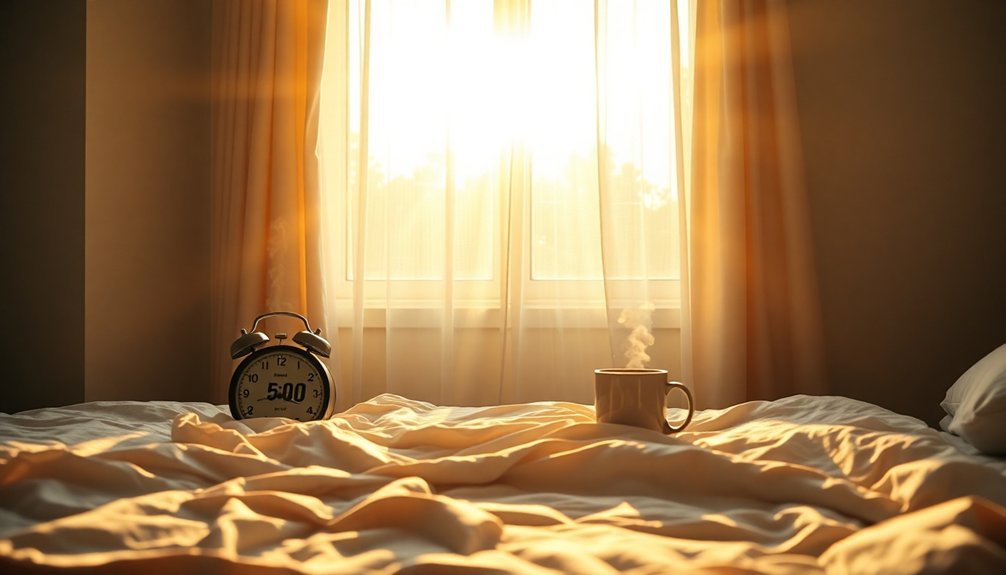
Everyone knows sunlight affects our mood, but its impact on our hormones runs far deeper. When you expose yourself to bright morning light, your brain's hypothalamus and pituitary gland spring into action, triggering a cascade of hormonal responses that can markedly boost your testosterone levels.
Research shows that morning light exposure increases luteinizing hormone (LH) by an impressive 69.5%. This matters because LH directly stimulates testosterone production. A study at the University of California, San Diego found that just one hour of exposure between 5-6 a.m. produced these significant hormonal changes.
At the same time, morning light suppresses melatonin (your sleep hormone) while increasing cortisol and serotonin, helping you feel more alert and energized.
Your body's internal clock is most sensitive to light during the morning hours, and approximately 100 different biological systems depend on proper synchronization with the earth's rotation.
When you get bright light exposure (at least 1,000 lux) in the morning, you're not just waking up – you're activating a complex network of hormonal responses that can enhance your overall health and performance.
The key is getting full-spectrum sunlight, as it contains the ideal ratio of blue to yellow light that your body needs to properly regulate these vital hormonal processes.
Peak Testosterone Hours Matter
Your body's natural testosterone production peaks between 7:00 and 10:00 AM, making this window essential for both hormone testing and activities that benefit from higher testosterone levels.
Early morning light exposure can boost your luteinizing hormone by nearly 70%, which directly impacts testosterone production. After age 30, your testosterone begins to decline 1-2% annually, making morning optimization even more crucial.
If you're looking to optimize your hormone levels, you'll want to sync your morning routine with these natural peaks and take advantage of bright morning light exposure.
Natural Production Window Times
The body's testosterone production follows a precise daily rhythm, with peak levels occurring between 7:00 and 10:00 AM. During these morning hours, you'll experience your highest natural testosterone output, which gradually declines throughout the day before rising again during sleep.
Your testosterone production is heavily influenced by your sleep patterns, particularly during REM sleep phases. When you're getting quality, uninterrupted sleep, your body can optimize hormone production during these vital nighttime hours. As you age, your testosterone's daily fluctuations decrease significantly, typically showing only a 10% variation by age 70.
You'll find that your morning levels are substantially higher than those measured in the afternoon or evening.
To maximize your natural production windows, you'll want to focus on consistent sleep schedules and morning light exposure. Early morning bright light increases your luteinizing hormone levels, which directly impacts testosterone production.
You should also consider that physical activity and stress throughout the day can affect your hormone levels, so it's beneficial to plan intense workouts during peak morning hours.
While age can diminish these daily fluctuations, maintaining regular sleep patterns and morning routines remains essential for optimizing your natural testosterone production windows.
Early Light Boosts Hormones
Bright light streaming in through morning windows can substantially boost your hormone production, particularly testosterone levels. When you expose yourself to bright light in the early morning, you'll trigger a 69.5% increase in luteinizing hormone (LH) compared to dim light exposure. This matters because LH directly stimulates testosterone production in your testes. The brain and pituitary gland work through a feedback loop system to maintain optimal testosterone levels throughout the day.
Your body's response to morning light involves multiple mechanisms. The light activates your pituitary gland to release LH, while your skin's keratinocytes respond to ultraviolet rays by signaling additional hormone production.
You'll also benefit from the vitamin D synthesis, which helps convert total testosterone into its free, bioavailable form.
If you're dealing with low sexual desire or suboptimal testosterone levels, morning light exposure can serve as a natural intervention. Studies show that consistent bright light exposure in the morning improves sexual satisfaction and overall hormone balance in men.
You're working with your body's natural circadian rhythm when you get morning light, as testosterone levels naturally peak early in the day. This timing synchronizes with your body's biological clock, maximizing the hormonal benefits of light exposure.
Light and Hormone Production

Through extensive research, scientists have discovered that morning light exposure plays a pivotal role in regulating male hormone production. When you're exposed to bright light in the morning, your body responds by increasing luteinizing hormone levels by nearly 70% compared to dim light conditions. This boost directly enhances testosterone-related hormone production.
You'll get the most significant hormonal benefits from bright white light, which triggers higher cortisol levels than dim white, red, or blue light. The timing is essential – early morning exposure is far more effective than afternoon exposure.
Your hypothalamic-pituitary-adrenal axis responds specifically to morning light through retinal projections to your brain's suprachiasmatic nucleus.
What's particularly significant is that light exposure offers more consistent and predictable hormonal benefits than other methods like cold exposure. When you expose yourself to bright light in the morning, you're not just suppressing melatonin; you're triggering a cascade of hormonal responses that include elevated cortisol, growth hormone, and prolactin levels.
These effects are well-documented and understood, making morning light exposure one of the most reliable ways to optimize your hormone production.
Circadian Rhythm Impact
Your body's natural testosterone levels peak around 8 a.m. each morning, following a precise 24-hour cycle that's governed by your circadian rhythm.
This daily hormone pattern affects not just testosterone but also other essential hormones that influence your energy, metabolism, and overall well-being.
Your sleep-wake cycle plays a vital role in maintaining these natural hormone rhythms, with disruptions potentially leading to imbalances in testosterone production and other metabolic processes.
Natural Testosterone Release Pattern
The human body orchestrates a precise hormonal dance throughout each 24-hour cycle, with testosterone reaching its peak between 8 a.m. and 9 a.m. Your brain's suprachiasmatic nucleus (SCN) controls this rhythm, acting as your internal clock and synchronizing hormone release with the day-night cycle.
During your sleep, particularly during REM sleep stages, your body ramps up testosterone production. You'll experience the highest testosterone surge during your first REM episode, which is why getting quality sleep is essential.
When you align your sleep-wake cycle with natural light patterns, you're supporting your body's ideal testosterone production schedule.
Your hormonal system operates through a complex network where GnRH and kisspeptin signaling drive testosterone production. When you maintain regular sleep patterns and expose yourself to natural morning light, you're reinforcing these biological rhythms.
However, if you disrupt this cycle through poor sleep habits or irregular light exposure, you'll likely experience decreased testosterone levels. That's because your cortisol levels can rise, interfering with the hypothalamic-pituitary-adrenal axis that regulates testosterone production.
Daily Hormone Production Cycles
While melatonin orchestrates your sleep-wake cycle, it's just one player in a complex daily hormonal performance. Your body's master clock, the suprachiasmatic nucleus (SCN), conducts this intricate symphony of hormones throughout each 24-hour period, responding primarily to light exposure and environmental cues.
Your testosterone levels peak in the morning hours, providing you with heightened energy and mental focus. As the day progresses, these levels gradually decline, shifting your biological emphasis toward teamwork and social interaction during midday. By evening, your testosterone reaches its lowest point, which naturally reduces your activity levels and libido.
Cortisol and DHEA follow similar patterns, reaching their highest concentrations in the early morning and decreasing throughout the day. These hormonal fluctuations directly impact your metabolism, spatial abilities, and impulse control. You'll notice that your energy levels and mood naturally align with these hormonal patterns.
The SCN's influence extends beyond just hormone production – it affects nearly every tissue and organ in your body, coordinating your physical, mental, and behavioral responses to maintain ideal function throughout the day.
Sleep-Wake Hormone Regulation
Understanding circadian rhythms reveals the complex interplay between your sleep-wake cycle and hormone production. Your testosterone levels follow a distinct 24-hour pattern, peaking between 8 a.m. and 9 a.m., while dropping to their lowest levels in the evening. This natural rhythm is controlled by your brain's suprachiasmatic nucleus (SCN), which acts as your body's master clock.
If you're disrupting your sleep patterns through shift work or insufficient sleep, you're likely compromising your testosterone production. Your body's hormonal system works in harmony – as testosterone helps regulate your circadian rhythm, it also influences your alertness and fatigue levels throughout the day.
Additionally, melatonin rises in the evening to promote sleep, while cortisol naturally peaks in the morning to wake you up.
To optimize your hormone production, you'll need to maintain consistent sleep patterns, ideally getting 7-7.5 hours of sleep per night. Both shorter and longer sleep durations can negatively impact your testosterone levels and sperm parameters.
Remember that artificial light exposure, especially in the evening, can disrupt these natural hormone cycles, affecting your overall hormonal balance and fertility.
Optimal Light Exposure Times

Morning light acts as a powerful catalyst for male hormone production, with research showing that early exposure between 5-6 a.m. can boost luteinizing hormone levels by nearly 70%.
You'll get the best results by exposing yourself to bright light (1,000 lux) for 30 minutes each day, as this mimics natural sunlight and helps regulate your circadian rhythms.
You'll want to maintain consistency in your light exposure routine, as studies show that following this practice for two weeks can markedly increase your testosterone levels and enhance sexual satisfaction. The timing is vital – early morning exposure aligns perfectly with your body's natural hormone production cycle.
Keep in mind that seasonal changes affect your hormone levels, with testosterone typically peaking in summer months and declining during winter. If you're experiencing winter's effects on your libido, you can counteract them through targeted light therapy.
You'll need bright light of at least 1,000 lux, which proves more effective than dim light (under 10 lux) for hormone regulation. Consider using a UV-filtered light box for safe, controlled exposure that can help maintain ideal testosterone levels throughout the year.
Red Light Therapy Benefits
Red light therapy's ability to energize your cells through enhanced mitochondrial function can substantially boost your daily energy levels and physical performance.
You'll experience improved cellular ATP production, which directly impacts your body's natural energy creation processes and overall vitality.
The therapy's wavelengths can also help optimize your testosterone levels by stimulating the Leydig cells in your testes, making it particularly beneficial for men seeking to maintain healthy hormone balance.
Cellular Energy Production Benefits
When it comes to cellular energy production, light therapy's most profound impact occurs at the mitochondrial level. Your cells' powerhouses – the mitochondria – are specifically activated by red and near-infrared wavelengths, triggering enhanced ATP production through the stimulation of cytochrome c oxidase.
This activation improves your cellular energy production efficiency, which is vital for every bodily function.
The electron transport chain in your mitochondria becomes more efficient, leading to increased ATP synthesis. When red light therapy dissociates nitric oxide from cytochrome c oxidase, your mitochondrial performance improves substantially, resulting in higher energy levels throughout your body.
- Your mitochondria produce more ATP when stimulated by red/NIR light
- Your cells' electron transport chain functions more efficiently
- Your cellular energy production increases through improved mitochondrial performance
- Your body experiences enhanced energy levels due to enhanced cellular respiration
This boost in cellular energy production isn't just about feeling more energetic – it's fundamental to your body's ability to repair, regenerate, and maintain peak function. The improved mitochondrial efficiency translates to better overall cellular health and enhanced performance across all bodily systems.
Testosterone-Enhancing Properties
Beyond cellular energy benefits, light therapy's impact on male hormones represents one of its most significant advantages. When your testicles receive red and near-infrared light exposure (630-940nm), specialized photoreceptors activate, triggering increased testosterone production through enhanced ATP generation in Leydig cells.
| Benefits | Mechanism |
|---|---|
| Hormone Production | Stimulates opsin proteins in testicles, tripling testosterone levels |
| Sperm Health | Improves concentration and motility without side effects |
| Sexual Function | Enhances libido and performance through better circulation |
You'll experience multiple advantages through this natural testosterone enhancement method. Unlike traditional hormone supplementation, red light therapy won't disrupt your spermatogenesis. Instead, it regulates your HPG axis while generating vasodilators that improve testicular blood flow. Clinical studies confirm these benefits, showing doubled testosterone levels and enhanced sexual function in men with low libido.
The therapy's effects extend beyond hormone production, supporting muscle mass development, athletic performance, and mood improvement. Most importantly, you'll achieve these benefits without risking DNA damage or experiencing negative side effects common with other testosterone-boosting methods.
Morning Vs Evening Results
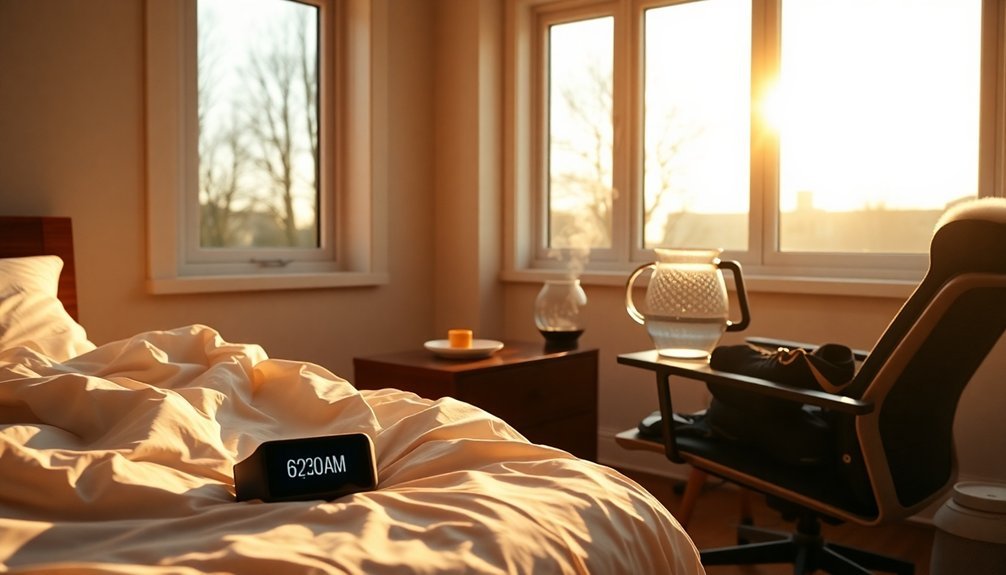
Testing has consistently revealed a stark difference between morning and evening testosterone levels in men. Your body's natural hormone production peaks between 7:00 and 10:00 AM, with levels reaching their highest point during this window.
If you're younger, you'll experience a more dramatic difference between morning and evening levels, showing up to a 35% variation, while this gap narrows to about 10% by age 70.
Your testosterone production follows a predictable daily pattern, dropping to its lowest point in the early evening, roughly 12 hours after the morning peak. This pattern is closely tied to your sleep cycle, which is why night shift workers may experience different timing in their peaks and troughs.
- Morning testosterone measurements (8:00-9:00 AM) provide the most accurate assessment of your hormone status
- Evening measurements aren't reliable indicators due to natural daily fluctuations of 10-25%
- Fasting morning tests yield the most accurate results, as food intake can suppress testosterone levels
- Bright morning light exposure can boost your luteinizing hormone levels, which in turn increases testosterone production
Natural Testosterone Enhancement Methods
A variety of natural methods can effectively boost your testosterone levels without requiring medical intervention.
You'll find substantial benefits from incorporating specific dietary choices, such as consuming high-protein foods like lean beef and fish, along with vitamin D-rich options including salmon and tuna. Adding magnesium-rich foods like spinach and nuts can increase your usable testosterone by preventing binding proteins from limiting its effectiveness.
Your lifestyle choices play a vital role too. You should prioritize getting 7-8 hours of sleep, as testosterone peaks during rest and can drop by 15% with insufficient sleep.
Strength training exercises will boost your levels more effectively than cardio, while morning exposure to bright light (10,000 lux) can markedly increase testosterone within two weeks.
You'll want to reduce your exposure to BPA by avoiding certain plastics and limit alcohol consumption, which can lower testosterone and increase estrogen.
Consider supplementing with proven options like ashwagandha, which can boost testosterone counts by up to 17%, and maintain adequate intake of vitamin D and magnesium.
Following a Mediterranean diet and managing stress levels will further support your body's natural testosterone production.
Light Intensity Requirements
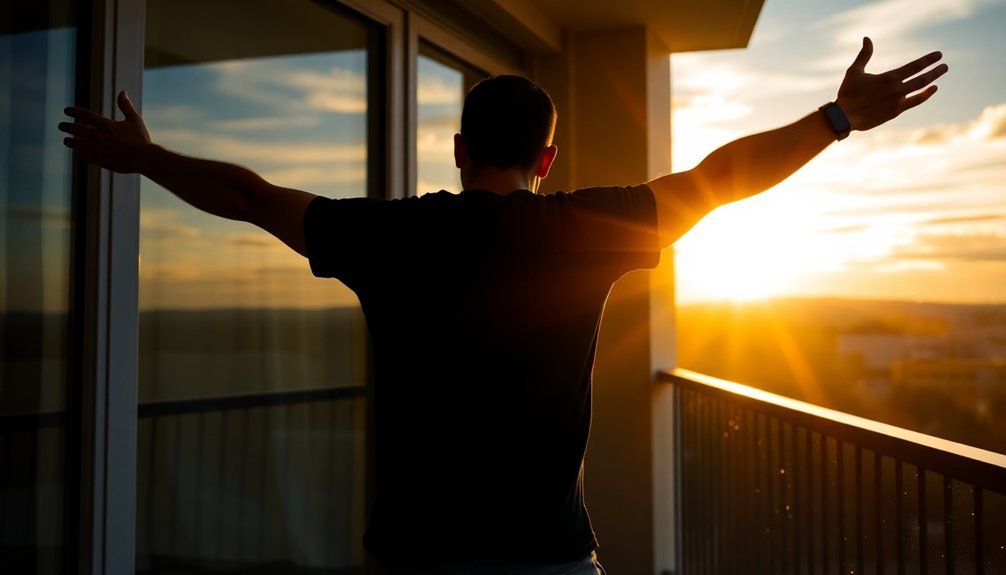
While morning light exposure offers powerful benefits for testosterone production, specific intensity levels determine its effectiveness. You'll need exposure to bright light at 1,000 lux for one hour between 5-6 a.m. to achieve the best results. Research shows this precise timing and intensity can increase luteinizing hormone (LH) levels by 69.5%, leading to higher testosterone production.
When it comes to light sources, you've got several effective options. Bright light boxes, similar to those used for Seasonal Affective Disorder, can boost testosterone levels and sexual satisfaction.
Red or infrared light in the 600-700nm range has proven particularly beneficial for testicular health and sperm production.
- Use bright light therapy for 60 minutes at 1,000 lux during early morning hours
- Consider red light therapy in short 2-5 minute sessions to avoid overheating
- Aim for direct sunlight exposure to torso and testes when possible, which can boost testosterone by up to 200%
- Avoid blue and UV light exposure, as these can harm testicular function
Consistency is key – maintain regular exposure patterns while being careful not to overdo it. Remember that more isn't always better, and protecting against excess heat is vital for maintaining the best results.
Seasonal Effects on Hormones
Seasonal changes substantially impact your hormone production throughout the year. Your testosterone levels naturally peak during summer months and drop markedly during winter, while your luteinizing hormone (LH) shows distinct peaks during spring and autumn. These variations aren't random – they're influenced by several environmental factors that you encounter daily.
Your testosterone production responds strongly to sunlight exposure and vitamin D levels, which explains why you'll typically have higher levels during sunny summer months. The length of daylight and environmental temperatures also play vital roles in regulating your hormone production. You'll notice these effects more prominently if you live in regions with distinct seasonal changes.
Your body's LH production follows a different pattern, with peaks occurring twice yearly in spring and autumn. Notably, you can boost your LH levels by exposing yourself to bright light in the early morning, which can increase production by nearly 70%.
While geographic location might affect these patterns, the fundamental seasonal rhythms of your hormones persist. Understanding these natural fluctuations can help you optimize your hormone levels through strategic light exposure throughout the year.
Daily Light Exposure Protocol
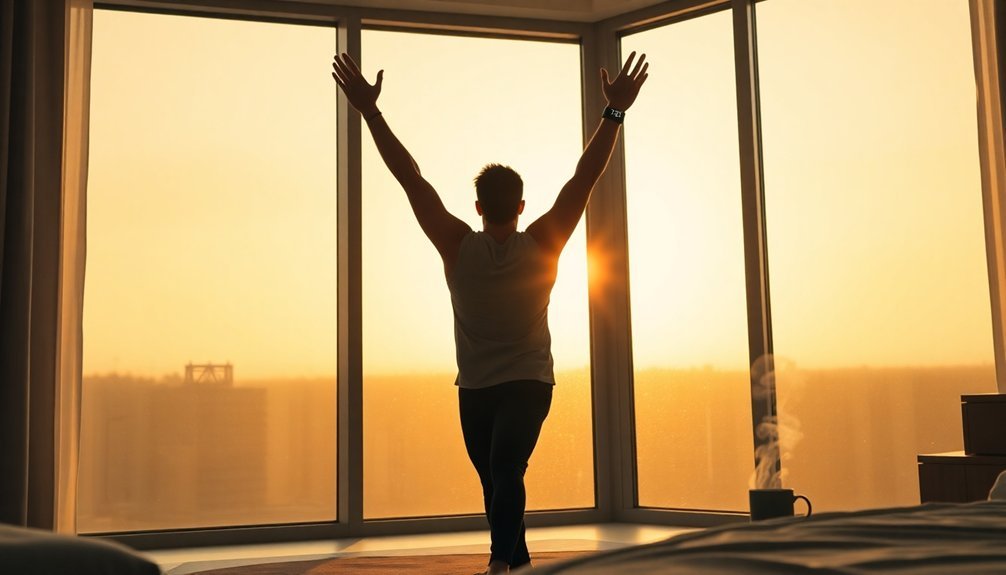
Maximizing your hormone levels requires a strategic approach to daily light exposure. You'll get the most substantial boost in testosterone and luteinizing hormone (LH) by exposing yourself to bright light in the early morning hours, particularly between 5-6 a.m.
Research shows that consistent exposure for just 20-30 minutes can dramatically increase your hormone production through the hypothalamic-pituitary axis.
The intensity of light matters considerably. You'll want to aim for exposure to bright light (1,000 lux or more) rather than dim light, as this triggers a more robust hormonal response. This exposure can increase your cortisol by 50% and LH levels by up to 69.5% when done consistently for five days.
- Get 20-30 minutes of bright light exposure immediately after waking
- Target 1,000 lux or greater light intensity
- Maintain consistency for at least five consecutive days
- Consider both natural sunlight and bright white light sources
While sunlight provides additional benefits through UVB exposure and vitamin D production, you'll need to balance these advantages against potential skin damage risks. If you're concerned about UV exposure, bright white light can still effectively boost your hormone levels through melatonin suppression and circadian rhythm regulation.
Frequently Asked Questions
Can Morning Light Exposure Help With Fertility Issues in Men?
Yes, morning light exposure can boost your fertility by increasing LH levels and regulating testosterone production. It'll help balance your hormones, improve sperm quality, and maintain healthy circadian rhythms for better reproductive health.
Does Artificial Indoor Lighting Negatively Impact Testosterone Production at Night?
Yes, artificial indoor lighting at night can lower your testosterone production. When you're exposed to blue light from devices and indoor lighting, it disrupts your circadian rhythm and interferes with natural hormone cycles.
How Does Morning Light Exposure Affect Cortisol and Stress Levels?
When you get bright morning light exposure, your cortisol levels naturally spike by up to 35%. You'll experience an immediate elevation in stress hormones, which helps regulate your body's healthy wake-and-alertness response.
Will Sunglasses Reduce the Hormonal Benefits of Morning Light Exposure?
Yes, wearing sunglasses will reduce your hormonal benefits from morning light exposure. They block essential light that stimulates hormone production, including luteinizing hormone and testosterone. You'll get better results without wearing them.
Can Morning Light Therapy Help Reverse Age-Related Testosterone Decline?
Yes, you can potentially help counter age-related testosterone decline with morning light therapy. While it won't completely reverse the decline, studies show it can boost your testosterone levels by up to 50% within two weeks.
In Summary
You'll maximize your testosterone levels by getting morning sunlight exposure between 6-9 AM when your hormones are naturally at their peak. Aim for 10-30 minutes of direct sunlight on your skin and eyes (without glasses). Combining this practice with proper sleep habits and maintaining a consistent light exposure schedule will help optimize your natural hormone production and strengthen your circadian rhythm year-round.
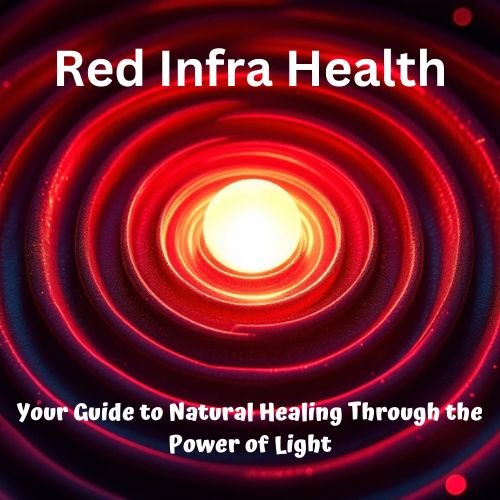


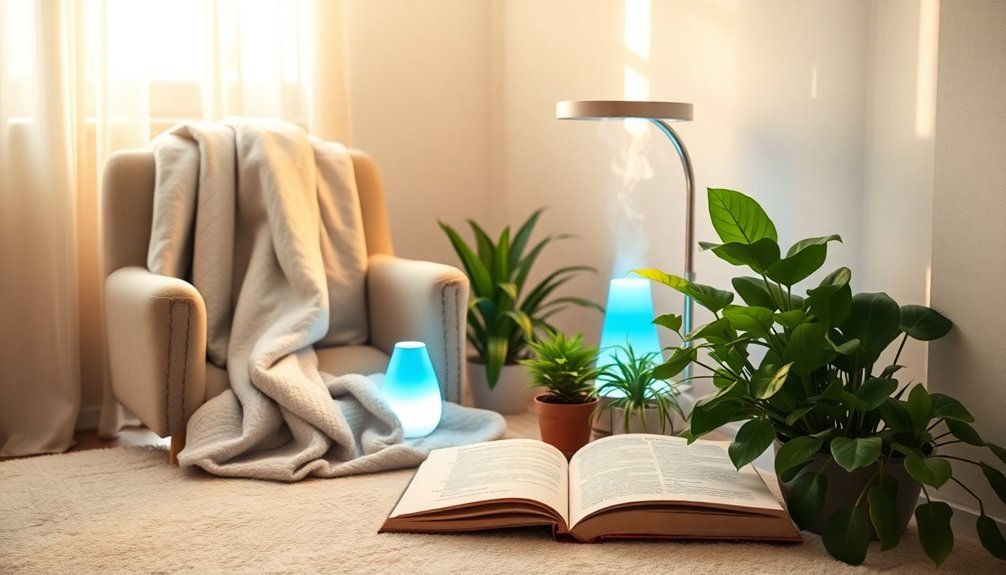
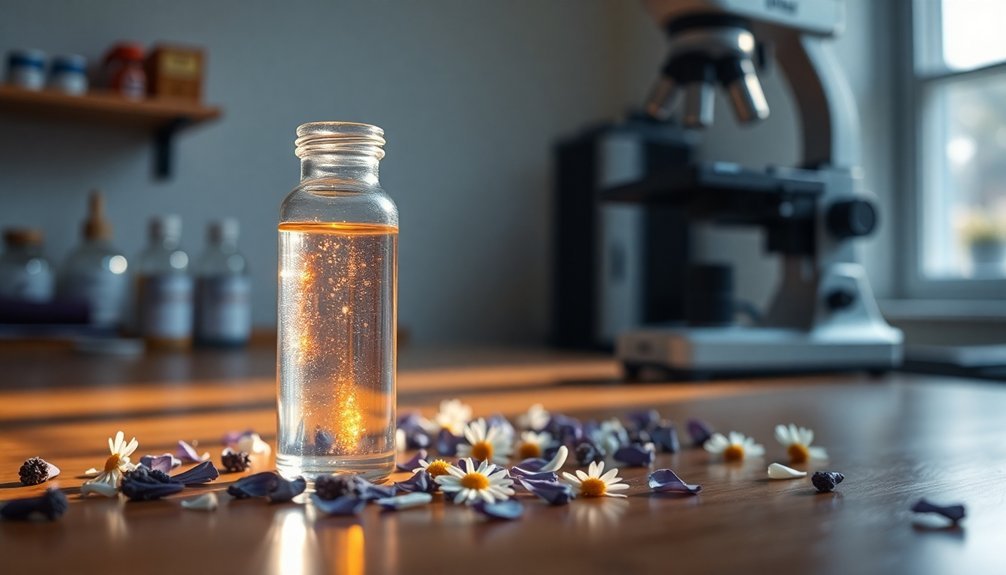
Leave a Reply